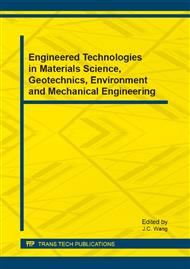[1]
G. Hallberg, R.D. Libra, B.E. Hoyer, Nonpoint source contamination of groundwater in karst carbonate aquifers in Iowa, Perspectives on nonpoint source pollution, Proc. of a national conference, Environ. Protection Agency, Washington, DC, 1985.
Google Scholar
[2]
J.H. Chen, The combined use of chemical and organic fertilizer and/or bio-fertilizer for crop growth and soil fertility, International workshop on sustained management of the soil-Rhizophere system for efficient crop production and fertilizer use, 2006.
[3] D.N. Rodriguez-Navarro, F. Temprano, R. Orive, Survival of Rhizobium sp. (Hedysarum coronarium L.) on peat-based inoculants and inoculated seeds, Soil Biol. Biochem. 23 (1991) 375-379.
DOI: 10.1016/0038-0717(91)90194-o
Google Scholar
[4]
M.W. Schwartz, J.D. Hoeksema, C.A. Gehring, N.C. Johnson, J.N. Klironomos, L.K. Abbott, A. Pringle, The promise and the potential consequences of the global transport of mycorrhizal fungal inoculant, Ecol. Lett. 9 (2006) 501-515.
DOI: 10.1111/j.1461-0248.2006.00910.x
Google Scholar
[5]
Y. Bashan, Inoculants of plant growth-promoting bacteria for use in agriculture, Biotechnol. Advances. 16 (1998) 729-770.
DOI: 10.1016/s0734-9750(98)00003-2
Google Scholar
[6]
G. Jung, J. Mugnier, H.G. Diem, Y.R. Dommergues, Polymer-entrapped Rhizobium as an inoculant for legumes, Plant Soil. 65 (1982) 219-231.
DOI: 10.1007/bf02374652
Google Scholar
[7]
P.E. Olsen, W.A. Rice, M.M. Collins, Biological contaminants in north American legume inoculants, Soil Biol. Biochem. 27 (1994) 699-701.
DOI: 10.1016/0038-0717(95)98650-d
Google Scholar
[8]
A. Sessitsch, P.K. Jjempa, G. Hardarson, A.D.L. Akkermans, K.J. Wilson, Measurement of the competitive index of Rhizobium Tropici strain CIAT899 derivatives marked with the GusA gene, Soil Biochem. 39 (1998) 1099-1110.
DOI: 10.1016/s0038-0717(97)00002-3
Google Scholar
[9]
H.Q. Wu, Y.B. Niu, J.P. Tian, C.Q. Sha, J.P. Li, The effect of nutritious substance and bacteriostatic agent on the shelf-life of biofertilizer, J. Microbiol. 25 (2004) 50-53.
Google Scholar
[10]
B.P. Liu, J.C. Zhou. Study on Rhizobium Inoculant, Hubei Agri. Sci. 45 (2006) 57-61. (in Chinese)
Google Scholar
[11]
J. Blazquez, Hypermutation as a factor contributing to the acquisition of antimicrobial resistance. Clin. Infect. Dis. 37 (2003) 1201-1209.
DOI: 10.1086/378810
Google Scholar
[12]
A. Couce, J. Blazquez, Side effects of antibiotics on genetic variability, FEMS microbial Rev. 33 (2009) 531-538.
DOI: 10.1111/j.1574-6976.2009.00165.x
Google Scholar
[13]
N.J. Zan. Rare earth bioinorganic chemistry, Beijing: Science Press, 1995, 298.
Google Scholar
[14]
P. Liu, Y. Liu, Z.X. Lu, J.C. Zhu, J.X. Dong, D.W. Pang, P.Q. Shen, S. Song, Study on biological effect of La3+ on Escherichia coli by atomic forcemicros-copy, J. Inorganic Biochemistry. 98 (2004) 68-72.
Google Scholar
[15]
J. Yang, H. Zhang, J.C. Wang, X.S. Liu, Y.P. Wu, F.H. Zhao, Inhibition of rare earth on bacteria and fungi, Chinese Rare Earth. 30 (2009) 35-39. (in Chinese)
Google Scholar
[16]
J. Yang, J.C. Wang, X.S. Liu, Y.P. Wu, H. Zhang, W. Zheng, Status of organic rare earth antibacterial effect, J. of the Chinese rare earth society. 25 (2007) 77-81, suppl. (in Chinese)
Google Scholar
[17]
M. Li, M. Alexander, Co-inoculation with antibiotic producing bacteria to increase colonization and nodulation by rhizobia, Plant Soil. 108 (1988) 211-219.
DOI: 10.1007/bf02375651
Google Scholar
[18]
G. Tyler, Rare earth elements in soil and plant systems - a review. Plant Soil. 267 (2004) 191-206.
DOI: 10.1007/s11104-005-4888-2
Google Scholar
[19]
B.Y. Wei, L.Z. He, S.Q. Gong, J.L. Li, A new method to selecting dye- decolorizing bacteria-decolorizing circle, Hunan Agri. Sci. 1 (2010) 10-12.
Google Scholar


